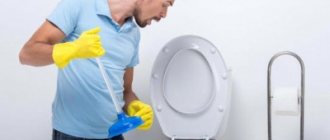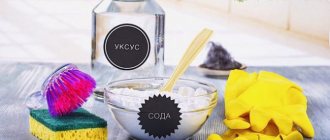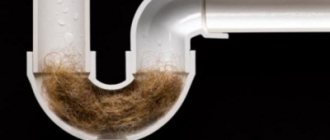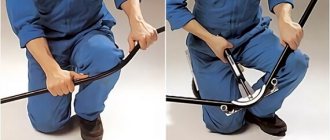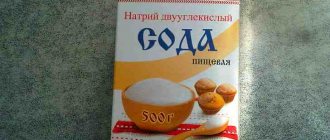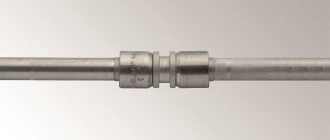If your kitchen sink is clogged, there are several ways to unclog it and restore normal water flow. In many cases, you can solve the problem without calling a specialist to your home, using folk recipes, household chemicals or simple plumbing fixtures.
Ways to clear a clogged sink.
Causes
During operation, a clog may form in the sink for several reasons:
- Incorrect installation of plumbing.
- The appearance of corrosion and the accumulation of fatty deposits.
- Foreign objects entering the drain - debris, hair, food debris, etc.
If the communications under the sink were installed incorrectly, with irregularities, then blockages can become a constant problem. In this case, only reinstallation will help, and clearing the blockages using any method will only give a temporary effect.
Causes and weaknesses of sewage systems
The sewerage system in a country house and apartment is designed together with the water supply. Two or three rooms with these engineering systems - a separate/combined bathroom and a kitchen - have a common water supply and sanitation system.
Typical sewerage scheme in an apartment.
Blockages can form due to improper operation of any of the plumbing fixtures. There are several categories of causes of sewer blockages:
- design – small diameter of pipes, slope angles of horizontal sections, incorrect relative position of plumbing fixtures;
Standard slope of internal sewerage. - technical – sagging of pipes in horizontal sections, use of metal pipes, burrs on the inside of pipes, rubber/seal sticking out inside;
Errors in assembling the drainage system. - operational – ingress of large fractions of dirt, food, household waste, hair. Most often, such blockages form in siphons, or where the sewer system has installation defects (for example, burrs).
Errors in sewerage operation.
Also, over time, pipes become “overgrown” with deposits, especially cast iron ones. But this happens quite slowly. The most likely place for deposits to appear is in horizontal sections of pipes, where water flows at a slower speed.
"Overgrown" pipes.
In the kitchen, food waste of small and large fractions inevitably enters the drainage system through the sink. This water intake point is usually farthest from the sewer riser located in the toilet. With small volumes of water and slope angles of horizontal sections of internal sewerage, the liquid does not have time to carry this waste into the riser.
There is an accumulation of organic matter in the pipes, up to a blockage, which the user will have to clear with improvised means. In addition, organic matter begins to be processed by bacteria. Pipe obstruction can occur in any area between the riser and the kitchen sink connection point. As a result, the functionality of any plumbing fixture in the kitchen, combined bathroom, bath or toilet may be impaired if the kitchen sink is connected to the sewer before the bathroom.
How to fix it mechanically?
When serious blockages occur with complete or partial blockage of wastewater outflow, mechanical cleaning methods have proven to be one of the most effective. In cases where the plug is formed by foreign objects, especially non-organic ones, such methods are the best.
plunger
One of the simplest devices for cleaning sinks and bathtubs is a plunger. The principle of working with it is not complicated:
- place the plunger vertically in a sink with water, holding it by the handle;
- press the handle and sharply lift the plunger up and towards you;
- repeat.
With severe blockages, a plunger may not be very effective.
Cup
If you don’t have a plunger and the blockage is not severe, you can even get by with a glass. How to use:
- Lower the glass into the sink with water so that the free edge covers the drain hole.
- With a sharp movement, lift the glass up and towards you.
- Repeat several times.
With complex blockages that completely block the flow of water, the cleaning procedure using a glass will not be effective.
Cable
A special plumbing cable is a device for cleaning sewers mechanically.
It is a cable, at one end of which there is a handle for rotation, at the other end there is a nozzle with a brush, which is intended for cleaning.
The principle of operation is to insert a cable with a brush at the end into the sewer. Turn the handle and move the tool along the drain to clean the pipes. The cable allows you to clear the drain even with complex blockages.
Mechanical methods
If you can't remove the plug, try piercing it.
Cleaning with a cable
Buying rope from a plumbing store. Wear rubber gloves and work clothes. Try not to act alone.
When using rope, please be careful not to damage the pipes.
- Carefully turning the handle, lower the twisted end into the pipe until it becomes clogged.
- Lift the clog and make a few back and forth motions to loosen it.
- When pulling out, immediately wipe the dirty surface, otherwise the entire bathroom will be dirty.
If there is no rope, make a hook from strong wire. Use it to hook and pull out dirt.
Opening the siphon bowl
Dismantling and cleaning the siphon will help remove clogged debris:
- Place a container under the siphon and place a rag next to it.
- Carefully unscrew the lock nut.
- Remove the flask.
- Wait until the liquid drains out.
- Clean with a brush and rinse the siphon.
- Reassemble the structure in reverse order.
When reassembling, remember that the pipe should not touch the flask, otherwise the siphon will be damaged. Open the tap to check for leaks. If necessary, unscrew and screw the structure again.
How to remove using folk remedies?
Simple homemade recipes are based on readily available products . They are not difficult to use. The main disadvantage of such products is their weak effectiveness against complex blockages. Traditional methods are suitable for preventing the formation of deposits in pipes during operation.
Boiling water
Hot water, or even better, boiling water, is a good way to clean drains, but only if the pipes are metal. This method is not suitable for plastic sewerage, as it can lead to deformation and other damage to the drainage system. Using boiling water is most effective for removing blockages in the kitchen.
How to use:
- boil at least 1.5 liters. water;
- pour water into the drain in a thin stream;
- leave for 30-50 minutes;
- repeat the washing procedure.
If the sewage system is plastic, you can use not boiling water, but simply hot water at a temperature of up to 65-70°C.
Vinegar with soda
Cleaning with baking soda and vinegar is an easy way to deal with untreated clogs. This option is also suitable as a means of prevention.
Application:
- Remove water from the sink and drain hole.
- Pour 100-200 grams of soda into the drain.
- Pour in ½ cup of vinegar.
- Plug the drain.
- After the reaction has occurred with the formation of foam (15-30 minutes), rinse the drain with boiling water.
Soda and salt
The product is suitable for removing grease deposits in the kitchen sink. Procedure:
- drain the drain;
- prepare a container for mixing ingredients;
- pour in 200-250 grams of water;
- add ½ cup of soda;
- add 1 glass of salt;
- mix;
- pour the solution into the drain;
- after an hour, use a plunger to break through the sink;
- pour the hot water down the drain.
How to prevent problems in the future?
Regular preventive maintenance will help you avoid trouble in the future. To protect the pipeline system from the accumulation of dirt lumps, the drain hole must be equipped with a simple device - a protective grill.
A large mesh metal or plastic mesh will trap hairs and animal fur without holding back the flow of waste water.
It is also worth pouring small portions of hot water into the drain every week. It will melt fat deposits, facilitating their further movement along the highway.
The use of chemicals has a good preventive effect. To achieve the desired result, they should be used at least once every six months. But to minimize the risk of pipe damage, they should be used in accordance with the instructions.
Any manufacturer’s line of “emergency” chemical preparations necessarily contains less concentrated preventive agents.
To minimize the risk of dirt seals forming, it is recommended to periodically disassemble and wash the siphon elements.
How to remove with special chemicals?
Special household chemicals can be used to unclog sinks. Such products are available in the form of powders or gels.
When choosing a specific drug, you must consider:
- price;
- consumption of the product (how many uses it is designed for);
- release form;
- speed of impact;
- composition (for septic tanks, the choice of chemistry should be especially careful).
It is important to study the information on the instructions for use on the packaging of the product.
Tiret Turbo, gel
The drug in gel form is aimed at removing blockages at home. The product contains chlorine and is suitable for cleaning plastic and metal pipes.
Tiret is effective, copes even with complex blockages in a short time, and carries out disinfection. Half the bottle is used for one treatment - the consumption is high. Cost – about 400 rubles. Read reviews here, here and here.
Bagi Pothan
Bagi is a granular solution for blockages, used in bathroom pipes, sinks, and toilets. Contains sodium hydroxide. The product is suitable for plastic and metal pipes.
Pothan is suitable for clearing blockages in kitchen and bathroom sinks. When released into the drain, the product begins to act effectively, dissolving:
- leftover food products,
- hair,
- diapers,
- paper,
- polyethylene.
Application:
- Remove excess water from the sink.
- Pour 70 to 100 grams of the drug into the drain.
- Pour in ½ cup of hot water.
- Leave for 3 minutes.
- Rinse with plenty of water.
- If necessary, the processing can be repeated.
The price for 0.6 kg is on average 700 rubles. The package is enough for at least 10 uses. Read reviews here, here and here.
Expel
The product is designed to remove hair blockages. The use of the drug is simple:
- Pour the contents of the package into the drain.
- Pour in a glass of warm water.
- After 30-50 minutes, rinse with plenty of water.
The product does not contain chlorine and is odorless. The product can be used prophylactically once a month. Price – up to 135 rubles. Read reviews here, here and here.
Chemicals
The cleanest way is to use home remedies. You can buy them at the store or make them yourself from ingredients you have in your kitchen.
Ready-made chemicals
The best clog remover depends on the pipe material. Please read the label before purchasing. Aggressive preparations containing acids and alkalis can only be poured into cast iron pipes. For plastic, choose a softer product.
The table below provides basic steps to prevent clogged sinks and bathtubs.
Table 1. Cleaning gels and powders
| Name | Active substance | Manufacturer | Volume, ml | price, rub. |
| "Mole" | Sodium hydroxide and acetic acid | Russia | 1000 | 35 |
| "Sanox" | Oxalic acid | Russia | 750 | 50 |
| Tiret | Chlorine bleach | Russia | 500 | 450 |
| Sanfor | Sodium hydroxide and hydrochloride | Russia | 750 | 120 |
| Chirton | Sodium hydroxide | Russia | 60 g | 30 |
| "Mister Muscle" | Sodium hydroxide | Russia | 70 | 85 |
| "Bagi Pothan" | Caustic soda | Israel | 600 g | 450 |
| Domestos ("Domestos") | Sodium hypochlorite | Russia | 500 | 400 |
Please read the instructions carefully. Pour the required amount of the drug into the hole and wait a certain time, then rinse. Keep hands and chrome parts away from aggressive substances. When the product has taken effect, leave the bathroom.
Pour in a small amount of cleansing gel as part of your monthly maintenance. This will prevent dirt clumps from forming.
Folk remedies
It is much safer for the environment and health to remove blockages using folk remedies. However, delicate substances cannot dissolve organic pollutants.
Soda
Follow the instructions:
- Pour 250 g of powder into the well and hold for 10 minutes.
- Rinse off with hot water.
If the clog is not completely removed, use a plunger or repeat the procedure.
Vinegar
Vinegar will enhance the effect of baking soda.
Vinegar and baking soda foam a lot.
Procedure:
- Pour a glass of vinegar and close the hole with a stopper.
- Wait ten minutes and rinse with boiling water.
This reaction will wash away the soap and limescale along with the clogged dirt.
Lemon
If the drain in the hole is blocked or there is little dirt, use lemon juice:
- Cut the fruit in half.
- Squeeze the juice from each half into the drain hole.
- Leave on for an hour and rinse off.
Use citric acid instead of juice. Dissolve the sachet in boiling water and pour it into the tube.
Siphon disassembly
The siphon under sinks is a dismountable device that can be cleaned by simply disconnecting it from the system. Despite the features of the models, the principle of organization of the devices is very similar. For the most part, cleaning is not difficult and can easily be done on your own, without the involvement of a plumber.
No complex tools or special skills are required for cleaning. The parts under the sink in plastic systems are fixed with plastic fasteners, which can be unscrewed simply by hand.
It must be taken into account that there is dirty water in the siphon. To prevent it from splashing, you should place a bucket or basin under the sink in advance.
When unwinding the siphon elements, it is necessary to monitor the condition of the gaskets. When they wear out, replacement will be required.
Clearing a clogged kitchen sink is shown step by step in the video:
Cleaning the siphon device
Stagnation of water, accompanied by the appearance of a characteristic unpleasant odor, may indicate that a plug has formed in the walls of the siphon. This structural element performs two tasks at once: it prevents the penetration of sewer odors and protects the system from the ingress of foreign objects.
If you accidentally dropped a small but valuable item down the drain, there is a high probability that it will settle in the siphon; removing it is not difficult by disassembling and cleaning the device
Before disassembling the siphon, directly under its location it is necessary to spread a piece of old cotton fabric that absorbs moisture well.
Cleaning the siphon is performed in the following sequence:
- A container with low sides is installed under the location of the siphon, into which liquid from the disassembled structure will drain.
- Unscrew the shutter nut and disconnect the flask from the outgoing pipe.
- The water, which served as a water seal, is drained from the flask.
- The bottom of the siphon is unscrewed and cleared of accumulated deposits by wiping the surface from the inside with a sponge and washing it with a stream of water.
- The flask is installed in its original place, docking with the outgoing pipe.
- Open the tap so that water fills the water seal and check the integrity of the connections.
When assembling the structure and installing the flask in its original place, it is important to place it in such a way that the drain pipe does not rest on it. If you do not adhere to this requirement, the water seal will be broken when starting the system. As a result, a persistent sewer smell will appear, which is quite difficult to get rid of in a short time.
When cleaning the inner walls of a disassembled siphon, you need to not only wash out the dirt lumps, but also remove the deposits that have formed on the walls
Lumps of garbage removed from the siphon should not be flushed down the drain so as not to clog the system. They are best disposed of as household waste.
Features of cleaning plastic pipes
Plastic pipes are the most common option for organizing sewerage . Most special anti-clogging products are designed for pipes made of any material, including plastic.
When cleaning plastic communications according to folk recipes, you need to use just hot water (up to 70°C) instead of boiling water. Otherwise, the pipes may be damaged.
Mechanical cleaning must also take into account the demanding nature of the material. Among chemical preparations, those containing potassium hydroxide and sodium give a good effect.
Mechanical cleaning using a cable
What to do in a situation where boiling water combined with a plunger cannot clear blockages in the sewer? In this case, the surest way would be a cable. Care should be taken, as this device can easily damage plastic pipes and cause them to leak.
To make a cable yourself, you will need a metal flexible wire. Then one end of the cable must be bent to form a small hook. It will be convenient for them to catch debris stuck in the drain hole and pull it out. As for the second end, a piece of fabric should be tied to it, making a handle.
You need to carefully insert the cable inside the drain pipe and try to push through the accumulated dirt. For better cleaning, you can rotate the device clockwise. Then you need to pull out the cable with the remaining debris.
To completely remove the clog, you need to flush the drain with a strong stream of boiling water from the shower or tap. This method is one of the most effective today. This is what most plumbers use.
Call a plumber
Seeking help from a specialist may be recommended in the following cases:
- there is no time or desire to bother with cleaning the sewer;
- it was not possible to solve the problem on our own;
- the blockage affects the riser or its location could not be determined.
A plumber will help you deal with any kind of blockage. If replacement of worn parts and assemblies is required at the same time, the customer pays for them separately.
On average, the cost of eliminating a household blockage in the capital is from 700 rubles. Finding a company providing such services in your city on the Internet is not difficult.
How to avoid blockages
Proper use of your home drains will help prevent blockages. It's very easy to do, so you won't need to spend a lot of time and effort.
To avoid blockages in the drain, you should follow these recommendations:
- Close the drain with a special device that can trap small debris and hairballs.
- Every 6 months it is necessary to clean the sewer with good cleaning products. Not only chemical mixtures are suitable, but also folk recipes.
- Every month you need to flush the drain pipeline by pouring boiling water into it or fully opening the hot water tap for a couple of minutes.
When the washing machine drains the liquid after washing, at this moment it is worth enhancing the effect by using a rubber plunger. Using strong movements you need to create additional pressure, which will flush the pipes and remove small debris.
Preventive measures
Prevention measures are not complicated , but thanks to them, problems with water drainage will occur much less frequently:
- It is advisable to install a special sieve in the sink drain holes (both in the kitchen and in the bathroom). It will help prevent large particles and hair from entering the drain.
- You should regularly pour boiling water down the drain (for plastic pipes - just hot water). This will prevent sediment from accumulating on the surface of drainage communications.
- You should not clean food residues, construction mixtures, water after washing shoes, etc. into the sink.
Other effective ways
If the bathtub is not too clogged, you can use lemon. To do this, squeeze the juice from three medium-sized citrus fruits into the drain and wait 40-60 minutes. To get more juice, you can first keep the lemons in boiling water. After this, you need to flush the drain with very hot water. Thanks to this method, not only the debris in the bath is eliminated, but also the unpleasant odor.
Video - proven cleaning methods:
You can remove dirt in the drain hole with a vacuum cleaner equipped with a backflow function. The action of this method is based on the use of strong air pressure. Experts do not recommend using this method, as water may get into the vacuum cleaner. If you nevertheless decide to remove the blockage in the bathtub using this method, you should wipe the rim of the drain hole dry. Then attach the vacuum cleaner tube, previously wrapped with a rag, to the drain and turn on the reverse blowing.
Prohibitions when cleaning
When removing a clog in the sink, it is recommended to take into account the following prohibitions:
- You should not mix several products at the same time, as this can result in the release of very caustic fumes, and a mixture of aggressive substances can even damage pipes;
- Do not use household chemicals with bare hands;
- When clearing a clog, you should remove away from the sink all foreign objects that could be accidentally splashed with chemicals - dishes, toothbrushes, towels, etc.
A few words about shower trays
The main problems in operating a shower stall are:
- frequent location of the drain hole near the wall;
- lack of access to the internal sewerage tee;
- major sealing of the pallet without the possibility of dismantling (especially homemade ones).
Because of this, access to the siphon is blocked and it is impossible to disassemble it. Therefore, it is advisable to use special shower drains whose internal filling is removable, which allows access to the pipe and can be cleaned with a cable.
Demountable shower drain.
The main reasons associated with a clog in the bathroom
The formation of blockages in most cases is a consequence of non-compliance with the rules , the use of sewer systems and plumbing fixtures, as well as their improper installation. But this cannot be called the negligence of the apartment residents either, since it is almost impossible to keep track of everything that ends up in the drain. But most often the root cause of blockage can be the following things:
- lint and threads after washing clothes;
- hair after shampooing;
- debris from rags and other things that are washed in the bathroom;
- pet fur.
And thanks to the combination of all these components, a dense lump is formed in the sewer pipe, preventing the normal drainage of water. But before you remove the blockage in the bathroom, you need to decide which method is suitable in a particular case. After all, there are quite a lot of them and therefore I would like to consider the most popular ones in more detail.
